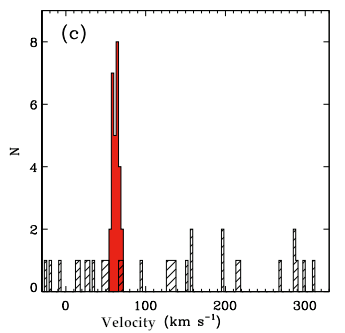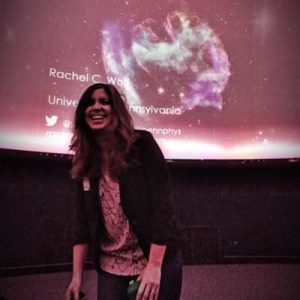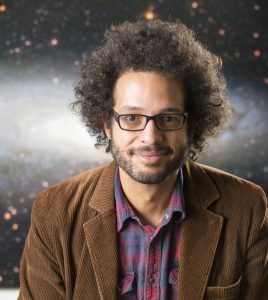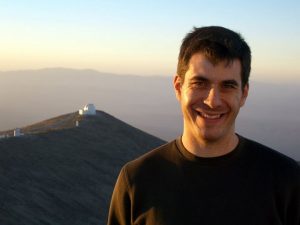Paper: Stellar Kinematics and Metallicities in the Ultra-Faint Dwarf Galaxy Reticulum II
Many large groups of stars, such as the recently discovered system known as Reticulum II, can be found by looking at the brightnesses and colors of stars in DES images. However, we still need additional, spectroscopic information to determine if some collections of stars are small galaxies formed outside our own Milky Way, or merely star clusters formed within it. Small (or ‘dwarf’) galaxies are made up mostly of dark matter, while star clusters have little, if any: this is one of the key distinctions between the two kinds of objects. Additional spectroscopic observations have allowed us to measure the velocity and metallicity (the amount of elements heavier than hydrogen and helium) of the stars associated with Reticulum II. From the velocities, it is possible to determine the amount of dark matter in the group of stars. From the metallicity, we can learn about how old the stars are and the formation history of the system.
Obtaining spectroscopic data is much more time-consuming than taking images with a camera, like DECam: spectroscopic observations require a special instrument, called a ‘spectrograph’. Like a prism, a spectrograph spreads out the light from star or galaxy, and one can find out how bright a celestial object is in many wavelengths (i.e., colors). In contrast, when DECam takes a picture, it can only show how bright an object shines in a few, select colors.
For these reasons, DES relies on data from other telescopes to get spectra. Fortunately, we were able to use some of the best telescopes in the world—Magellan, VLT and Gemini, all based in Chile—to study Reticulum II. Velocity measurements were performed with Magellan, while VLT and Gemini were used to measure metallicities. These observations had to be taken only a few months after Reticulum II was discovered by DES, as – like all objects in the night sky – its location changes over the course of the year and once it sets below the horizon it would not be visible for another six months.
Below is a graph showing the velocity distribution of observed stars in the system. The red peak indicates what we call the ‘velocity signature’ of Reticulum II. The hatched observations are stars we observed, but are not part of the Reticulum II system.

Fig. 1 from Simon et al., 2015
From the measured velocities of the stars in Reticulum II (the width of the red peak shown above), we find that this system contains hundreds of times more dark matter than the visible matter of the stars — a clear sign that this is a dwarf galaxy. This makes Reticulum II the first spectroscopically confirmed ultra-faint dwarf galaxy found outside of the region observed by the Sloan Digital Sky Survey. While the velocity measurements tell us about the dark matter composition of Reticulum II, the metallicity measurements also teach us something very interesting: Reticulum II is very metal-poor, containing fewer heavy elements than all but one previously discovered dwarf galaxy. This implies that this might be one of the oldest star systems discovered so far!
It has been postulated that dark matter may be made up of particles that could collide with each other and produce gamma rays. The large amount of dark matter in dwarf galaxies, like Reticulum II, make them good targets for gamma-ray searches of dark matter annihilation. Based on the velocity data and a model for the dark matter halo, the density of Reticulum II is low. Thus, the expected annihilation signal for Reticulum II isn’t as large as that for expected for some previously discovered dwarf galaxies: it isn’t the best candidate for finding signals of dark matter annihilating with itself.
In a broader context, dwarf galaxies have the most dark matter ‘per capita’ of any object that has been observed in the universe. They are probes of dark matter and the growth of structure at the smallest celestial size scales. They also tell us about galaxy formation, how matter comes together in galaxies, and Galactic archeology. Reticulum II is the newest confirmed nearby dwarf galaxy to be carefully studied. Over the next few years, more dwarf galaxies from DES data will be examined spectroscopically, leading to an even better understanding of our Milky Way neighbors.
About the Paper Authors
Josh Simon grew up in Ann Arbor, MI, but not wanting to go to college a mile from his parents’ house, he came out to California and went to Stanford instead. The west coast seemed pretty nice – and had lots of opportunities for astronomy – so he’s stayed there ever since. He went to graduate school at UC Berkeley and finished his PhD there in 2005, and then he moved down to LA. After completing postdoctoral fellowships at Caltech and Carnegie Observatories, a nonprofit research institute across town from Caltech, he was fortunate to land a permanent job as an astronomer at Carnegie. Outside of work, his time tends to be dominated by his wife and two sons (ages 2 and 4) and/or playing soccer and softball.

Alex Drlica-Wagner is a Schramm fellow at Fermi National Accelerator Laboratory (FNAL) in Batavia, Illinois. His research interests are focused on satellite/dwarf galaxies, dark matter and gamma rays. In his spare time, he throws disk with the Chicago Wildfire (http://chicago-wildfire.com/)
About The DArchive Authors & Editors

Rachel C. Wolf is an astrophysics PhD candidate at the University of Pennsylvania. She is primarily interested in how to best use Type Ia supernovae to understand more about the evolution of our universe. Most of her work has focused on studying correlations between supernova brightness and host-galaxy properties and on creating new statistical techniques to compare observational data to cosmology theory. Rachel is also very passionate about science education and public outreach. She is involved in many projects in the Philadelphia community and serves as one of the co-coordinators of Education & Public Outreach for DES.

Brian Nord is a post-doc at Fermi Accelerator National Laboratory. He did his graduate work on galaxy clusters and simulations of large-scale structure at the University of Michigan. He has been working with the DES strong lensing group for the past 3 years. Nord is also one of the co-coordinators of Education & Public Outreach for DES. Nord also does time lapse photography and has an encyclopedic memory of movies and television from the 1980’s.
